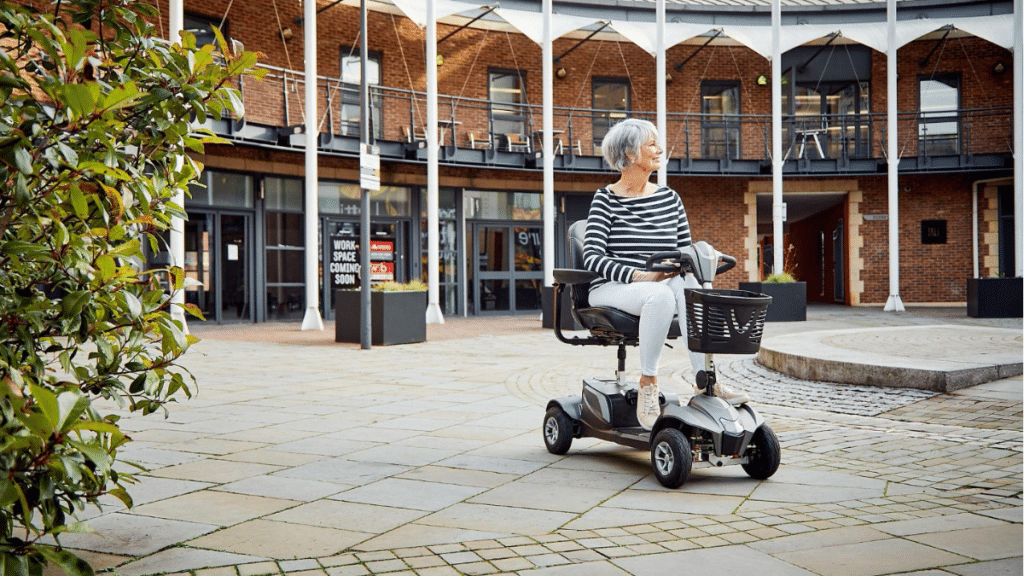So, you have a new mobility scooter! That’s a fantastic step towards greater freedom and independence. But, like with any new vehicle, there are a few things to get to grips with to ensure you’re getting the best—and safest—experience.
At Wheel Freedom, we’re here to support you on your journey. That’s why we’ve put together this handy guide to driving your mobility scooter with confidence.
What Kind of Scooter Do You Have?
First things first, let’s get to know your scooter. They generally fall into two main categories:
- Class 2 Scooters: These are the smaller, more compact models, many of which can be conveniently folded and stored in a car boot. They’re perfect for trips to the shops and navigating pavements.
- Class 3 Scooters: These are the larger, more robust scooters. With bigger batteries, they offer a greater travel range and are designed for use on both pavements and roads.
Where Can You Drive Your Scooter?
Knowing where you can ride is key to staying safe and on the right side of the law.
- Pavements: Both Class 2 and Class 3 scooters are well-suited for pavement use. It’s the safest place for you to be, but it’s important to remember that you’ll be sharing the space. Always be mindful of pedestrians, especially those with pushchairs, young children, or disabilities. A little courtesy goes a long way!
- Roads: If you have a Class 3 scooter, you also have the option of driving on the road. This is great for longer journeys, but there are a few important rules to follow. You must stay off motorways and avoid bus or cycle lanes. Additionally, you must not use dual carriageways with a speed limit over 50 mph. For a comprehensive overview of the legal requirements, the Highway Code is your best friend.
Staying on the Right Side of the Speed Limit
Just like any other vehicle, mobility scooters have speed limits:
- Class 2 Scooters: These have a maximum speed of 4 mph (6 km/h), which is a comfortable pace, slightly faster than the average walking speed.
- Class 3 Scooters: These can reach speeds of up to 8 mph (12 km/h). However, you’re only legally allowed to travel at speeds over 4 mph when you are on the road. When on the pavement, you must stick to the 4 mph limit.
Weights and What You Can Carry
It’s important to be aware of your scooter’s capabilities.
- Class 3 scooters can weigh upwards of 23 stone.
- The much lighter Class 2 scooters typically have a maximum user weight of around 17 ½ stone, and the scooter itself can weigh as little as 3 stone.
Just as important is the load your scooter can bear. Think about any shopping, bags, or medical equipment you might be carrying. To keep your scooter stable, avoid hanging bags from the handlebars. Most scooters come with a handy basket at the front, and there are often other accessories available, like canopies, cup holders, and bag covers, to make your journey more convenient.
Parking Your Scooter
When you’re ready to park, be considerate of others. Make sure your scooter isn’t blocking the way for pedestrians or wheelchair users. All the usual parking restrictions apply to mobility scooter users, so a quick check of the Highway Code is always a good idea if you’re unsure.
Getting Your Scooter Road-Ready
If you have a Class 3 scooter and plan to use it on the road, it must legally be equipped with:
- Lights
- A horn
- Working brakes
- Indicators
- A rear-view mirror
Remember to use your lights when it’s dark. For added safety, consider wearing reflective clothing or adding reflective strips to the back of your scooter to enhance your visibility.
Leasing Through the Motability Scheme
If you’re leasing your scooter through the Motability Scheme, you’ll be pleased to know that you’re covered for:
- Insurance: In the event of an accident, you should report it to Direct Line Motability (DLM) via the ‘Insurance’ section of your Motability Scheme online account.
- Breakdown: If your scooter breaks down, get to a safe place and then call Motability Assist on 0800 953 5000. They will get you and your scooter home, and your dealer will follow up with any necessary repairs.
- Tyres: Tyres that are damaged through normal use can be replaced (subject to a fair usage policy). This also includes puncture repairs for air-filled tyres.
- Batteries: If you have any issues with your battery, contact your dealer, who can arrange a replacement. Batteries typically last between one and three years.
A Note on Eyesight
Good eyesight is essential for judging distances, recognizing potential dangers, and protecting both yourself and others when you’re driving your scooter. Although it’s not a legal requirement, we recommend having an eyesight test every two years and always wearing your driving glasses if you have them.
Mobility Scooter Requirements at a Glance
To round things off, here are a few key points:
- Mobility scooters are designed for those who have trouble walking, whether due to an injury, a physical disability, or a medical condition.
- Children under the age of 14 are limited to using Class 2 scooters only.
- Class 3 scooters must be registered with the DVLA.
- You are not required to pay road tax for a mobility scooter.
- You do not need a driving licence to operate a mobility scooter under any circumstances.
We hope this guide has been helpful. If you have any more questions, please don’t hesitate to get in touch with the team here at Wheel Freedom. We’re always happy to help you on your journey to greater independence.
